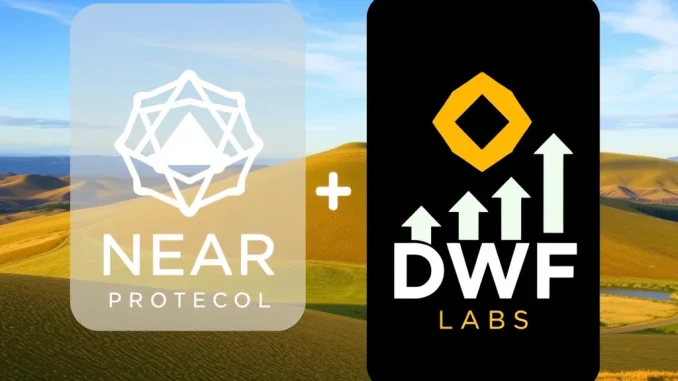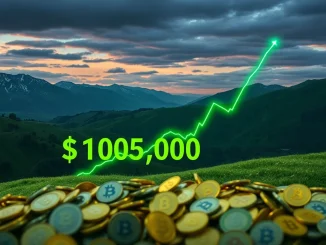
Understanding the underlying economics of a blockchain is crucial for anyone involved in the crypto space. For holders and users of NEAR Protocol, recent news regarding a proposed change to the network’s tokenomics is particularly significant.
What’s Happening with NEAR Protocol’s Inflation?
The team behind NEAR Protocol recently announced a major proposal via their official X account: a plan to reduce the network’s annual inflation rate from the current 5% down to 2.5%. This is a substantial proposed cut, aiming to halve the rate at which new NEAR tokens are introduced into circulation.
Why is this happening? The core reasons cited are:
- To improve the long-term sustainability of the network’s economic model.
- To support the value of the NEAR token by potentially reducing selling pressure from new token issuance.
- To better align incentives across the ecosystem, benefiting token holders, validators, and developers alike.
Understanding Crypto Inflation: Why Does it Matter for NEAR Crypto?
In traditional finance, inflation refers to the decrease in the purchasing power of a currency. In the context of cryptocurrency, crypto inflation typically refers to the rate at which new tokens are minted and added to the total supply. This is often used to reward validators (or miners) for securing the network and processing transactions.
A higher inflation rate means the supply of tokens grows faster. While necessary for network security and operation, excessive inflation can dilute the value of existing tokens if demand doesn’t keep pace with the supply increase. Conversely, a lower inflation rate can contribute to scarcity, which can be a positive factor for the token’s value over time, assuming consistent or growing demand.
For NEAR crypto holders, a reduction in the inflation rate could signal a move towards a more deflationary or disinflationary model, potentially making the token a more attractive long-term holding.
How Will This Change Happen? The Validator Vote
This isn’t a change that happens overnight or by executive decision. As a decentralized network, significant protocol changes like this require community consensus, typically expressed through validator voting.
Here are the key details about the voting process:
- Who Votes? Network validators, who are responsible for securing the NEAR blockchain.
- Voting Period: The voting on this specific proposal is open and will run through the end of July 2025.
- Requirement: The proposal needs to secure the required majority vote from validators to pass.
- Implementation: If approved, the new 2.5% inflation model will be integrated and activated in the next scheduled protocol upgrade following the vote’s conclusion.
This extended voting period gives validators ample time to consider the proposal’s implications and cast their vote, reflecting the decentralized governance process of NEAR Protocol.
What Are the Potential Benefits of Lower NEAR Token Inflation?
Reducing the inflation rate could have several positive ripple effects throughout the NEAR ecosystem:
1. Enhanced Token Value Proposition: With fewer new tokens entering the market, the selling pressure from inflation rewards is reduced. This could help stabilize or potentially increase the value of the NEAR token, making it more appealing for investors and long-term holders.
2. Improved Network Sustainability: While inflation rewards validators, they represent a cost to the overall ecosystem (through dilution). A lower inflation rate means the network relies less on continuous token issuance, potentially making its economic model more sustainable in the long run.
3. Aligned Incentives: A lower inflation rate encourages validators and token holders to focus more on the long-term health and adoption of the network, rather than solely on inflationary yield. This aligns the incentives of all participants towards the growth and success of NEAR Protocol.
4. Increased Scarcity: Over time, a lower inflation rate means the total supply grows much slower. This relative scarcity, combined with potential increases in network usage and demand, could be bullish for the token.
Are There Any Challenges or Considerations?
While the benefits seem clear, any major tokenomics change requires careful consideration. Validators will need to weigh:
- Whether the reduced inflation rewards are still sufficient to incentivize a robust and secure validator set.
- The potential impact on staking yields and how that might affect participation.
- The overall health of the network and its ability to generate revenue through transaction fees, which also contribute to validator rewards.
The long voting period allows for these discussions and analyses within the validator community.
Why is This Big News for Blockchain News Followers?
This proposal highlights a maturing trend in the blockchain news cycle: protocols are actively managing their tokenomics to ensure long-term viability. It shows that Layer-1 networks like NEAR are thinking strategically about supply mechanics beyond just initial distribution and basic staking rewards. It’s a governance action demonstrating the network’s commitment to sustainable growth and value accrual for its token holders.
Looking Ahead: What’s Next for NEAR?
The focus now shifts to the validators and the ongoing vote. The outcome, expected after July 2025, will be a pivotal moment for NEAR Protocol‘s economic future. If the proposal passes, the implementation will be eagerly watched by the community and the broader crypto market.
This move by NEAR Protocol is a clear signal of their commitment to building a robust and sustainable ecosystem. By addressing crypto inflation head-on and proposing a significant reduction, they are taking steps they believe will strengthen the network and the value proposition of the NEAR token for years to come.
Conclusion: A Pivotal Moment for NEAR Protocol
The proposal to cut the annual inflation rate from 5% to 2.5% marks a critical juncture for NEAR Protocol. This strategic move, currently in the hands of the network’s validators, aims to bolster long-term sustainability, enhance the value of the NEAR token, and align ecosystem incentives. The outcome of the vote by July 2025 will shape the future economic landscape of the network, potentially setting a new standard for managing crypto inflation in Layer-1 blockchains. Keep an eye on this significant development in the blockchain news.



